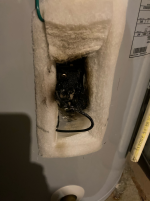LarryFine
Master Electrician Electric Contractor Richmond VA
- Location
- Henrico County, VA
- Occupation
- Electrical Contractor
I have a customer with an electric water heater that overheated the internal wiring. He asked me to re-wire it. He already bought two new T-stat/over-temp units.
Is regular THHN/THWN/2 adequate, or is something with a higher temperature rating better? I know they come with #12 internal wiring, but should I use #10?
Is regular THHN/THWN/2 adequate, or is something with a higher temperature rating better? I know they come with #12 internal wiring, but should I use #10?


